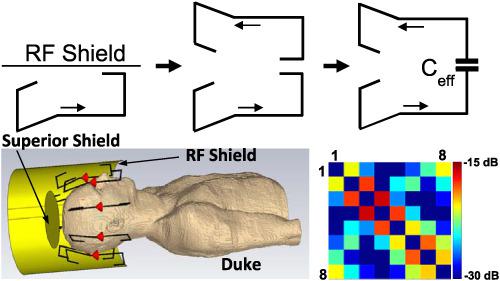当前位置:
X-MOL 学术
›
NMR Biomed.
›
论文详情
Our official English website, www.x-mol.net, welcomes your feedback! (Note: you will need to create a separate account there.)
Decoupling of folded-end dipole antenna elements of a 9.4 T human head array using an RF shield.
NMR in Biomedicine ( IF 2.9 ) Pub Date : 2020-07-02 , DOI: 10.1002/nbm.4351 Nikolai I Avdievich 1 , Georgiy Solomakha 2 , Loreen Ruhm 1 , Klaus Scheffler 1, 3 , Anke Henning 1, 4
NMR in Biomedicine ( IF 2.9 ) Pub Date : 2020-07-02 , DOI: 10.1002/nbm.4351 Nikolai I Avdievich 1 , Georgiy Solomakha 2 , Loreen Ruhm 1 , Klaus Scheffler 1, 3 , Anke Henning 1, 4
Affiliation

|
Dipole antennas have recently been introduced to the field of MRI and successfully used, mostly as elements of ultra‐high field (UHF, ≥ 7 T) human body arrays. Usage of dipole antennas for UHF human head transmit (Tx) arrays is still under development. Due to the substantially smaller size of the sample, dipoles must be made significantly shorter than in the body array. Additionally, head Tx arrays are commonly placed on the surface of rigid helmets made sufficiently large to accommodate tight‐fit receive arrays. As a result, dipoles are not well loaded and are often poorly decoupled, which compromises Tx efficiency. Commonly, adjacent array elements are decoupled by circuits electrically connected to them. Placement of such circuits between distantly located dipoles is difficult. Alternatively, decoupling is provided by placing passive antennas between adjacent dipole elements. This method only works when these additional components are sufficiently small (compared with the size of active dipoles). Otherwise, RF fields produced by passive elements interfere destructively with the RF field of the array itself, and previously reported designs have used passive dipoles of about the size of array dipoles. In this work, we developed a novel method of decoupling for adjacent dipole antennas, and used this technique while constructing a 9.4 T human head eight‐element transceiver array. Decoupling is provided without any additional circuits by simply folding the dipoles and using an RF shield located close to the folded portion of the dipoles. The array reported in this work demonstrates good decoupling and whole‐brain coverage.
中文翻译:

使用射频屏蔽对 9.4 T 人体头部阵列的折叠端偶极天线元件去耦。
偶极天线最近被引入 MRI 领域并成功使用,主要用作超高场(UHF,≥ 7 T)人体阵列的元件。用于 UHF 人体头部发射 (Tx) 阵列的偶极天线仍在开发中。由于样品的尺寸要小得多,偶极子必须明显短于体阵列。此外,头部 Tx 阵列通常放置在刚性头盔的表面,该头盔足够大以容纳紧密配合的接收阵列。结果,偶极子负载不好并且通常去耦很差,这会影响 Tx 效率。通常,相邻的阵列元件通过与其电连接的电路去耦。在距离较远的偶极子之间放置这种电路是困难的。或者,通过在相邻偶极子元件之间放置无源天线来提供去耦。此方法仅在这些附加组件足够小(与有源偶极子的大小相比)时才有效。否则,无源元件产生的射频场会破坏性地干扰阵列本身的射频场,之前报道的设计使用了大约阵列偶极子大小的无源偶极子。在这项工作中,我们开发了一种新的相邻偶极天线去耦方法,并在构建 9.4 T 人体头部八单元收发器阵列时使用了该技术。通过简单地折叠偶极子并使用位于偶极子折叠部分附近的射频屏蔽,无需任何附加电路即可提供去耦。这项工作中报告的阵列显示出良好的去耦和全脑覆盖。
更新日期:2020-08-04
中文翻译:

使用射频屏蔽对 9.4 T 人体头部阵列的折叠端偶极天线元件去耦。
偶极天线最近被引入 MRI 领域并成功使用,主要用作超高场(UHF,≥ 7 T)人体阵列的元件。用于 UHF 人体头部发射 (Tx) 阵列的偶极天线仍在开发中。由于样品的尺寸要小得多,偶极子必须明显短于体阵列。此外,头部 Tx 阵列通常放置在刚性头盔的表面,该头盔足够大以容纳紧密配合的接收阵列。结果,偶极子负载不好并且通常去耦很差,这会影响 Tx 效率。通常,相邻的阵列元件通过与其电连接的电路去耦。在距离较远的偶极子之间放置这种电路是困难的。或者,通过在相邻偶极子元件之间放置无源天线来提供去耦。此方法仅在这些附加组件足够小(与有源偶极子的大小相比)时才有效。否则,无源元件产生的射频场会破坏性地干扰阵列本身的射频场,之前报道的设计使用了大约阵列偶极子大小的无源偶极子。在这项工作中,我们开发了一种新的相邻偶极天线去耦方法,并在构建 9.4 T 人体头部八单元收发器阵列时使用了该技术。通过简单地折叠偶极子并使用位于偶极子折叠部分附近的射频屏蔽,无需任何附加电路即可提供去耦。这项工作中报告的阵列显示出良好的去耦和全脑覆盖。



























 京公网安备 11010802027423号
京公网安备 11010802027423号